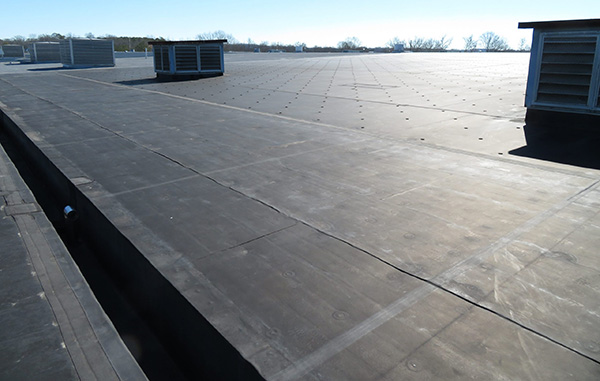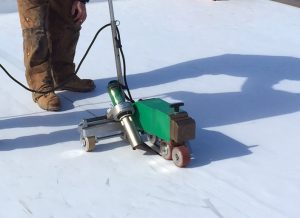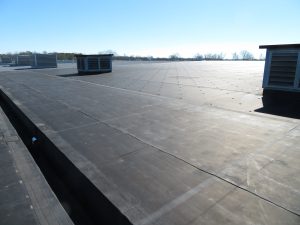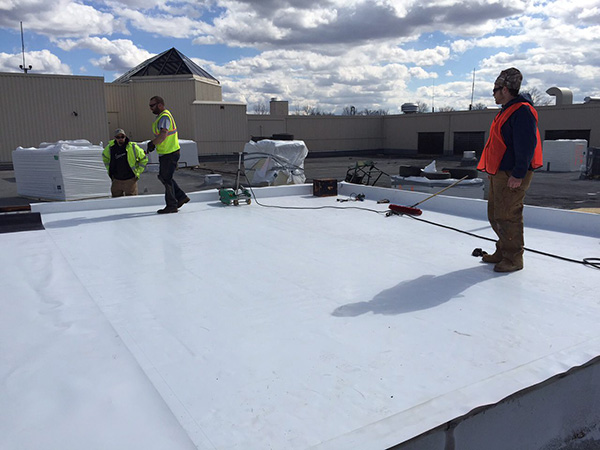Single-ply membrane roofing is one of the most popular for commercial roofing on the commercial market, the benefits of installing a single-ply membrane roofing system, rather than another roof type, are numerous regarding installation, performance, cost, and longevity.

Single-Ply Membrane Roofing Systems are:
- Over 50 years of proven performance
- Customer choice of application methods
- Class A fire-rated
- Choice of white or black for UV reflection or heat retention
- High-tensile strength
- Easy and quick installation
Read More: Pros and Cons of Single-Ply Membrane Commercial Roofing
West Roofing Systems has installed all types of roofing, and none of them are without problems. Our Maintenance and Repair Service (M.a.R.S.) team follow up with our customers to keep their roofing systems in tip top shape.
The Basics
There are two main types of single-ply membrane commercial roofing: Thermoplastic Polyolefin (TPO) and Ethylene Propylene Diene Terpolymer (EPDM).
Thermoplastic Polyolefin is a single-ply roofing membrane that is one of the fastest growing commercial roofing systems on the market. TPO roofing systems are made up of a single layer of synthetics and reinforcing scrim that can be used to cover flat roofs.
Ethylene Propylene Diene Monomer is a single-ply membrane that consists of a synthetic rubber compound that allows it to be flexible. EPDM has been used on commercial roofing facilities since the 1960s and is considered a time-tested option.
Installation

After the existing substrate is prepared, either by cleaning or removing the existing roof, the insulation layers are installed. A cover board is placed on top for the membrane to be adhered to.
The membrane is then attached to the cover board one of three ways:
- Ballasted
- Mechanically Fastened
- Chemically Adhered
The significant difference between TPO and EPDM comes when it is time to adhere the seams together. TPO membrane is rolled out, and the contractor then returns and uses a hot-air gun to hot air weld the seams together. EPDM membrane is rolled out on the flat roof, then the contractor returns and secures the seams with a layer of seam tape or an additional adhesive.
Read More: Single-Ply Membrane Commercial Roofing: Installation and Performance
Now that you know the basics, these are a few common problems we see with Single-Ply Membrane Roofing and how you can solve them:
1. Membrane is Easily Punctured
While a roofing system with a single-ply membrane can be walked on, the lightweight and flexible, membrane layers are easily punctured.

From roofing contractors to maintenance crews, there can be a high volume of traffic on your roofing system. Single-ply membrane roofing does not have a hard-top layer to protect the synthetic rubber from dropped tools, gravel or loose screws from being pushed into the rubber membrane. This kind of damage could create holes in the rubber and insulation and be vulnerable to leaks.
Solution: The best solution is prevention. Here are some tips to help prevent punctures in your roofing systems:
- Keep nearby tree limbs trimmed
- Consider putting down protective mats in areas that get the most foot traffic
- Keep roof system clean of debris and loose equipment
- Install warning signs to remind workers to keep their work areas clean
In the case of a puncture occurring to your roof system, a contractor will be able to repair a single-ply membrane roofing system relatively quickly with these steps:
- Clean the surrounding area
- Prime the area with a bonding adhesive
- Cut a piece of membrane 2” bigger than the puncture
- Use an adhesive or hot-air gun to bond the new piece of membrane onto the roof
Read More: How Puncture Resistant Are Commercial Roofing Membranes?
2. UV Rays Can Degrade the Adhesives

Adhesives are used to not only attach the membrane to the substrate but also to seal the seams of the membranes together. If UV rays shine directly on the roof can degrade the adhesives quickly over time.
This is what can make those seams vulnerable to leaks. If there is a puncture, tear or other damage to the roof, the UV rays coming onto the adhesive layer can cause more damage with the adhesives deteriorating.
Solution: When installing correctly, the membrane sheets should be overlapping and blocking the adhesives from UV rays. Therefore, it’s important to find contractors that are efficient and reliable during the single-ply membrane roof installation.
3. Expired Warranty
When you install a new roofing system, it’s best to purchase a warranty. Most manufacturer warranties require the contractor to perform repairs for the first few years after the install.
Warranties for a single-ply membrane roofing system can be 15, 20 or 30 years. It’s important to stay on top of your warranty because when your warranty expires, you are prone to high maintenance and repair bills if your facility encounters problems.
Solution: With Single-Ply Membrane Roofing, since there is no top coating, when your warranty is up you have two options to renew your warranty:
- New silicone restoration membrane
- New roofing system such as SPF roofing
No roofing system is immune to needing repairs, that’s why it’s important to keep up your warranty and work with contractors that you trust.
Single-Ply Membrane Roofing Systems is the long-time go-to roofing for commercial, industrial, and manufacturing facilities that are looking for a sustainable, economically efficient option.
At West Roofing Systems, our goal is to get you a long lasting, durable roof that will protect your facility. That includes working with our award-winning team to choose the best roofing systems to meet your needs.


